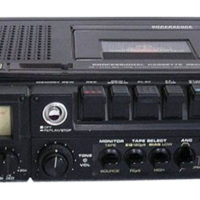
Came across this old photo (circa 1988) today and was — once again — struck by the gear we used. This is Lisa Wolfe, a reporter for The Missourinet.
The Radio Shack recorder is jacked into the Shure mixer which is wired into the big cart deck and the phone. So a reporter recorded audio from the phone (with a push-to-talk button in the hand piece); they then dubbed the audio bits they wanted to carts which they carried into the studio for newscasts. When they went into the field they unplugged the cassette recorder.
There were better recorders available but they were all much more expensive than the Radio Shack model which was damn near disposable. The problem was the buttons. Using the recorders as the did (endlessly starting, stopping, fast-forwarding, rewinding) trashed the buttons in no time.
The early SuperScopes (by Marantz) were good but every time they came out with a new model with more features, the buttons got flimsier and flimsier. And the recorders got more and more expensive. And they were nearly impossible to repair. So… Radio Shack.
Thinking back on those days, it occurs to me the cassette recorder was — in some ways — the laptop computer of that day. In the sense that it was our main tool for creating the content of the day (for us): audio.
Of course you needed a radio station or (in our case) a network of radio stations. But we sort of took that for granted.




